Related Research Articles

Ashtamudi Lake, in the Kollam District of the Indian state of Kerala is a unique wetland ecosystem and a large palm-shaped water body. It is second only in size to the Vembanad estuary ecosystem of the state. Ashtamudi means 'eight hills or peaks' in the local Malayalam language. The name is indicative of the lake's topography with its multiple branches. The lake is also called the gateway to the backwaters of Kerala and is well known for its houseboat and backwater resorts. Ashtamudi Wetland was included in the list of wetlands of international importance, as defined by the Ramsar Convention for the conservation and sustainable utilization of wetlands. Ashtamudi Estuary is the deepest among all the estuaries in Kerala, with a maximum depth of 6.4 meters at the confluence zone.
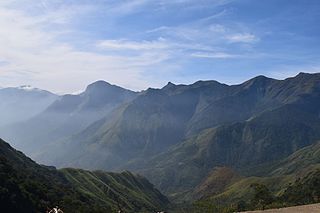
Silent Valley National Park is a national park in Kerala, India. It is located in the Nilgiri hills and has a core area of 89.52 km2 (34.56 sq mi). It is surrounded by a buffer zone of 148 km2 (57 sq mi). This national park has some rare species of flora and fauna. Silent Valley National Park was explored in 1847 by the botanist Robert Wight. It is located in the border of Mannarkkad Taluk of Palakkad district, Nilambur Taluk of Malappuram district, Kerala, and Nilgiris district of Tamil Nadu.
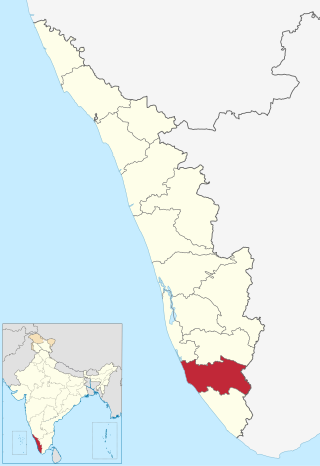
Kollam district, is one of 14 districts of the state of Kerala, India. The district has a cross-section of Kerala's natural attributes; it is endowed with a long coastline, a major Laccadive Sea seaport and an inland lake. The district has many water bodies. Kallada River is one among them, and land on the east bank of the river is East Kallada and that on the west bank is West Kallada.
Bio reserved of india full map of india
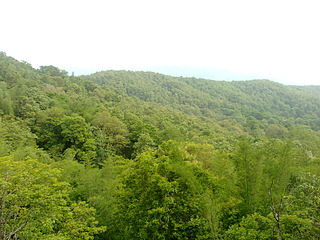
Parambikulam Tiger Reserve, which also includes the erstwhile Parambikulam Wildlife Sanctuary, is a 643.66 square kilometres (248.5 sq mi) protected area lying in Palakkad district and Thrissur district of Kerala state, South India. The Wildlife Sanctuary, which had an area of 285 square kilometres (110 sq mi) was established in part in 1973 and 1984. It is in the Sungam range of hills between the Anaimalai Hills and Nelliampathy Hills. Parambikulam Wildlife Sanctuary was declared as part of the Parambikulam Tiger Reserve on 19 February 2010. Including the buffer zone, the tiger reserve has a span of 643.66 km2. The Western Ghats, Anamalai Sub-Cluster, including all of Parambikulam Wildlife Sanctuary, has been declared by the UNESCO World Heritage Committee as a World Heritage Site. The Tiger Reserve is the home of four different tribes of indigenous peoples including the Kadar, Malasar tribe, Muduvar and Mala Malasar settled in six colonies. Parambikulam Tiger Reserve implements the Project Tiger scheme along with various other programs of the Government of India and the Government of Kerala. The operational aspects of administering a tiger reserve is as per the scheme laid down by the National Tiger Conservation Authority. People from tribal colonies inside the reserve are engaged as guides for treks and safaris, and are provided employment through various eco-tourism initiatives. Parambikulam Tiger Reserve is among the top-ten best managed Tiger Reserve in India. The tiger reserve hosts many capacity building training programmes conducted by Parambikulam Tiger Conservation Foundation in association with various organisations.

Kulathupuzha is a town in the eastern part of Kollam district of Kerala, India. It is one of the important pilgrim spots linked with the legend of Sabarimala. It is the birthplace of the Malayalam music composer Raveendran. Kulathupuzha is the source of the Kallada river, Thenmala Dam (KIP) is located on this river. As declared by the Governor Arif Mohammad Khan, Kulathupuzha panchayat is the first in India to have achieved Constitution-literacy.

Shendurney Wildlife Sanctuary is a protected area in the Western Ghats, India, located in Kollam district of Kerala and comes under the control of the Agasthyamalai Biosphere Reserve. It was established on 25 August 1984 and comprises 172.403 square kilometres (66.565 sq mi). The name is a corruption of the Chengurinji, a tree endemic to the region. The sanctuary has an artificial lake of nearly 18.69Sq.km size and also surrounded by the reservoir of Thenmala Dam. The Shendurney Wildlife Sanctuary is a treasure house of plant diversity. About 1257 species of flowering plants belonging to more than 150 families are reported from this sanctuary of which 309 species are endemic to Western Ghats. Birds from 267 species including migratory, endemic and endangered species have been reported here.

N. S. Memorial Institute of Medical Sciences (NSMIMS) is a co-operative hospital located at Palathara in Kollam, India. It was founded in 2000 in memory of N. Sreedharan, a communist organizer who was a member of the secretariat of the Communist Party of India (Marxist). This is the first Co-operative Multi Super Specialty Hospital in South Kerala. The hospital has 32 specialty departments and 95 doctors including 25 post graduate doctors and more than 950 medical and paramedical staff. It has a full range of services.

Chinnakada or Chinnakkada is considered as the heart of the city of Kollam in Kerala, India. Chinnakada is a busy junction where 5 city roads and one National highway interconnect at a traffic roundabout. The city's symbolic clock tower is located in Chinnakada. To reduce the traffic congestion in Chinnakada, Kollam Municipal Corporation constructed an underpass near to clock tower. Marine Products Export Development Authority (MPEDA)'s Kollam sub-regional office is situated at Chinnakada.

The Asramam Maidanam or Ashramam Maithanam is an urban park, or maidhanam, in the city of Kollam, in Kerala, India. At 72 acres (29 ha), it is the largest open space within Kerala Municipal Corporation limits. The maidan is considered one of the green lungs of the city and regularly hosts the city's main cultural and sports events. It holds an adventure park children's park, picnic village, British Residency and mangrove forests making it an important tourism spot in the city.

The International Synthetic Turf Hockey Stadium is a hockey stadium situated at the city of Kollam, first of its kind in Kerala state, with a nominal capacity of around 5,000 seats.

Quilon Aerodrome or Kollam Airport was an aerodrome in the city of Kollam in the former state of Travancore, now in Kerala, India. During the 1920s, there were no other civil aerodromes in the kingdoms of Cochin, Travancore and the Malabar District at the time of the British ruled Madras Presidency. With the commissioning of Trivandrum International Airport in 1932 at state capital 57 kilometres (35 mi) to the south, the aerodrome fell into disuse and came to be known as the Asramam Maidan.

The Asramam Link Road is an important four-lane city road in Kollam in the Indian state of Kerala. This road was formerly known as Airport Road or Aerodrome Road as it was the connection road to Kollam Airport, the one and only airport in the entire Kerala coast then. The road starts from Kappalandimukku near Polayathode in the east and currently ends at KSRTC, but is ultimately planned to extend to Thoppilkadavu in the west of the city. The Rs.114 crore worth third phase of construction includes a 3 km long flyover, which would extend it from Kollam KSRTC Bus Station to Thoppilkadavu, is going on now.

Asramam or Ashramam is one of the prime locations in Kollam city of Kerala, India. It is one among the 55 wards of Kollam Municipal Corporation. Asramam is a notable place in the city because of the presence of old airport, public/private institutions, tourism destinations, parks, hospitals, maidan etc. Asramam Maidan, the biggest open space now existing in any of the Kerala Municipal Corporation limits is situated at Asramam. The first airport in the state of Kerala, Kollam Airport, was functioned in this maidan. Asramam is the headquarters of the Kollam branches of Indian Medical Association and Sports Authority of India. Link Road, one of the important roads in the city, passing through Asramam. The one and only International Hockey Stadium in the state is at Asramam. srenarayana open university asramam walk way around the asramam ground

Chinnakada Clock Tower is a landmark in Kollam City in the Indian state of Kerala. In Chinnakada, the tower lies in the heart of the city, close to Kollam Junction Railway Station. As the first clock tower in the erstwhile Travancore state, it has become a non-official emblem of the city and the major landmark of Kollam.

Asramam Adventure Park is an urban park in the core Kollam city of Kerala state. It was opened after 1980, on 48 acres (19 ha) of city-owned land. Located beside the Kerala's pride, backwaters of Ashtamudi, this place popularly known as Asramam Picnic Village. It is the main centre of recreational activities in Kollam city. The Kollam District Tourism Promotion Council conducts regular backwater cruises in houseboats, luxury boats and speedboats from the Boat Club. The mangroves near this park is very famous in all over India. So many endangered species of trees are surviving in the park.
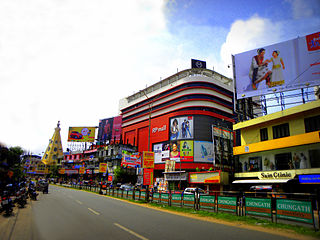
Kollam or Quilon is an old seaport and a city on the Laccadive Sea coast in Kerala, India, on Ashtamudi Lake. The city remains notable as the ancient commercial capital of Kerala and the southwestern Indian coast, in addition to its fame as the "Cashew Capital of the World". The Kollam Municipal Corporation has the second largest budget in Kerala in terms of revenue and expenditure.

City of Kollam or Quilon is a Port city in South India and was the commercial capital of erstwhile Kingdom of Travancore. It is situated on the Laccadive Sea coast of South Kerala. The city is known as the "Gateway to the backwaters of Kerala". The city lies on the banks of Ashtamudi Lake, Kerala's second largest lake, on the Arabian sea coast. Major parts of Kollam city are covered by Ashtamudi Lake.

Kollam Port Road or Port Road, Kollam is a four lane road in the city of Kollam, India. The 2.8-kilometre-long (1.7 mi) road connects historic Port of Quilon and Vaddy with Kochupilamoodu in the city through Kollam Beach.
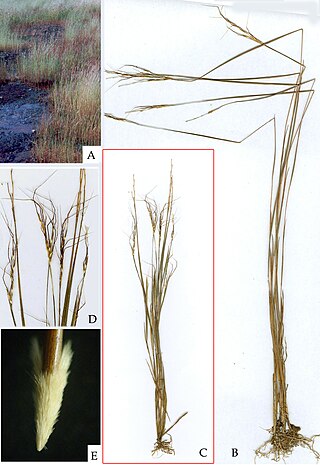
Nanooravia is a monotypic genus of flowering plants belonging to the family Poaceae. The only species is Nanooravia santapaui, an annual grass, and its native range is Southern India.
References
- ↑ "Biodiversity Heritage Sites - Kerala State Biodiversity Board". keralabiodiversity.org. 10 October 2022.
- ↑ Pereira, Ignatius (27 July 2017). "State's first biodiversity heritage site in Kollam". The Hindu.
- ↑ "Ahead of International Biodiversity Day, a peek into Kerala's only biodiversity heritage site". www.onmanorama.com.
- ↑ Khan, Ashhar (8 June 2024). "CWC Urges Rahul to Take Over as LoP in Parliament, Sonia Re-elected CPP". www.deccanchronicle.com.
- ↑ "Biodiversity heritage tag for Asramam mangroves soon". The Hindu. 14 March 2013.